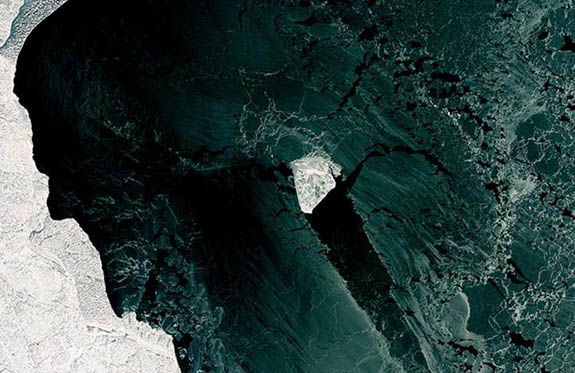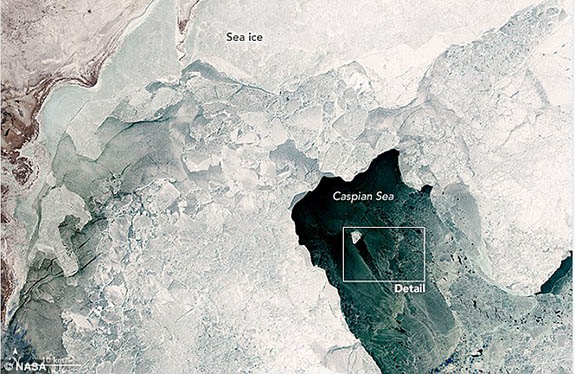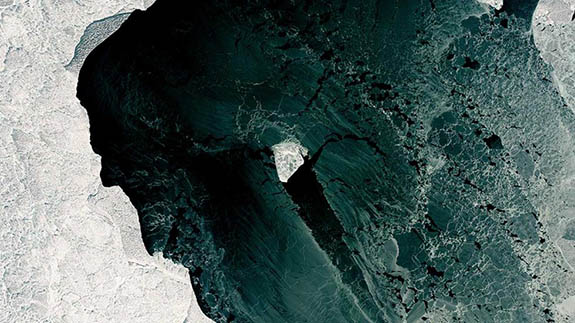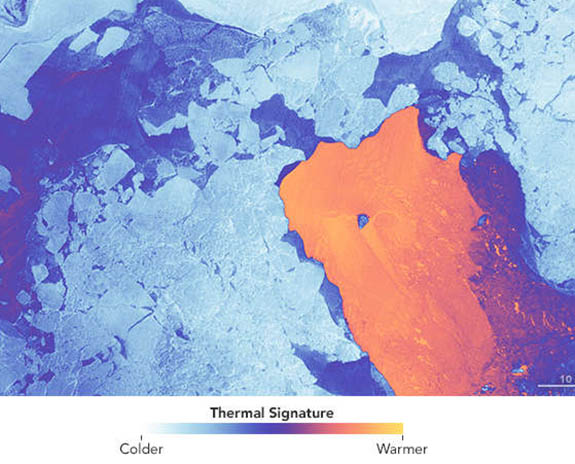March 7th, 2017
NASA’s Landsat 8 satellite spotted a glistening diamond-shaped ice jewel while orbiting above the cold, 600-mile northern region of the Caspian Sea — the world's largest inland body of water — stretching from Kazakhstan to Iran. The image of Ice Diamond was captured on February 4 by NASA's Operational Land Imager (OLI), a high-tech camera attached to the satellite.

IFL Science reported that the Ice Diamond likely had been chipped off from the larger sea ice and then became grounded to the seabed. Northern areas are more prone to freezing in wintertime than southern parts. NASA noted that the wind is pushing thinner darker pieces of ice called "nilas" around the diamond, leaving a shadow of open water where currents can move around it.

According to NASA's Earth Observatory, which published the image, the northern part of the Caspian Sea is less saline and shallower than the southern part. Lower temperatures and higher latitudes make it more prone to freezing than the southern areas.
NASA noted to Daily Mail that the ice captured in the images from OLI in February is all known as first-year ice and will not make it through the summer. The images from warmer months often reveal a series of "scour marks" left behind on the seafloor by the jagged edges of the grounded ice that stuck around all winter.

“This ‘island’ of white ice is most probably a piece that detached from the ice field,” explained Alexei Kouraev, a scientist at the Laboratory of Geophysical and Oceanographic Studies in France who spoke to the NASA Earth Observatory. “With the advance of spring and rising temperatures, ice on the Caspian will soon disappear. All of the ice is first-year ice, meaning that it should not survive the summer.”
Next to the Ice Diamond “hummocking” can be seen — weak, thin ice formed over the sea and then broken up by currents, waves and wind. When the pieces pile up on top of each other and then get locked back into an ice floe, they form hummocks that extend down several meters.

NASA also released an image of the area with thermal data, noting that the image will turn more orange as the weather warms. The sparkling diamond-shaped ice jewel will then disappear back into the sea forever.
Credits: Images via NASA.

IFL Science reported that the Ice Diamond likely had been chipped off from the larger sea ice and then became grounded to the seabed. Northern areas are more prone to freezing in wintertime than southern parts. NASA noted that the wind is pushing thinner darker pieces of ice called "nilas" around the diamond, leaving a shadow of open water where currents can move around it.

According to NASA's Earth Observatory, which published the image, the northern part of the Caspian Sea is less saline and shallower than the southern part. Lower temperatures and higher latitudes make it more prone to freezing than the southern areas.
NASA noted to Daily Mail that the ice captured in the images from OLI in February is all known as first-year ice and will not make it through the summer. The images from warmer months often reveal a series of "scour marks" left behind on the seafloor by the jagged edges of the grounded ice that stuck around all winter.

“This ‘island’ of white ice is most probably a piece that detached from the ice field,” explained Alexei Kouraev, a scientist at the Laboratory of Geophysical and Oceanographic Studies in France who spoke to the NASA Earth Observatory. “With the advance of spring and rising temperatures, ice on the Caspian will soon disappear. All of the ice is first-year ice, meaning that it should not survive the summer.”
Next to the Ice Diamond “hummocking” can be seen — weak, thin ice formed over the sea and then broken up by currents, waves and wind. When the pieces pile up on top of each other and then get locked back into an ice floe, they form hummocks that extend down several meters.

NASA also released an image of the area with thermal data, noting that the image will turn more orange as the weather warms. The sparkling diamond-shaped ice jewel will then disappear back into the sea forever.
Credits: Images via NASA.

